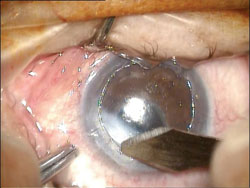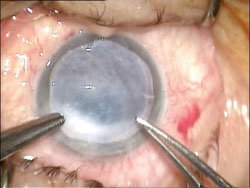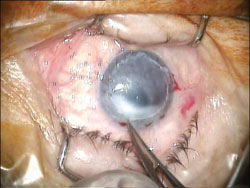Suturing technique effective for treating bullous keratopathy
Amniotic membrane procedure resulted in rapid epithelialization and less pain compared with the standard suturing procedure.
A modified amniotic membrane transplantation suturing technique afforded rapid epithelialization, maintained visual acuity and minimized pain in patients with symptomatic bullous keratopathy.
 Ugur E. Altiparmak |
The standard suturing technique yielded longer epithelialization time and shorter retention of amniotic membrane, a study found.
“We found that when we used this modified technique of [amniotic membrane transplantation], the epithelialization time is significantly shorter and the amniotic membrane survives significantly longer, which we believe are two important findings and make this technique worth performing in this group of patients,” Ugur E. Altiparmak, MD, said in an interview with Ocular Surgery News.
Penetrating keratoplasty is the standard treatment for bullous keratopathy. A lack of donor corneas spurred the development of treatments such as bandage contact lenses, stromal micropuncture, conjunctival flaps and phototherapeutic keratotomy.
Amniotic membrane transplantation (AMT) is an appropriate interim procedure to relieve pain in patients waiting to undergo PK, Dr. Altiparmak said.
 Before the amniotic membrane is sutured to the recipient cornea, a stromal pocket is made within the 8.5-mm mark using a blade. |
 The amniotic membrane disc is placed on the bed of the de-epithelialized area of the recipient cornea, and its edges are placed into the stromal pockets. |
|
Images: Altiparmak UE |
“PK or lamellar techniques are definitely the prime solutions for this group of patients,” he said. “But in our area, it’s hard to find donor corneas for transplantation. So we have to make these patients wait for long periods of time. We wanted to keep them pain-free for longer periods of time, until they would get PK or lamellar surgeries.”
Study results are published in the American Journal of Ophthalmology.
Modified intrastromal suturing technique
The randomized clinical trial included 39 eyes of 39 patients randomly assigned to AMT with the modified suturing technique (first group, 21 patients) or the standard technique (second group, 18 patients). Mean patient age was 74.3 years in the first group and 70.6 years in the second group.
Mean preoperative logMAR visual acuity of 1.4 was similar between both groups.
In the modified intrastromal suturing technique, the edges of the punch-shaped amniotic membrane are sutured into a groove made in the recipient cornea, with the basement membrane side facing upward. An “inlay” technique promotes epithelialization atop the AMT, not under it, the study authors said. With the inlay technique, the amniotic membrane acts as a graft.
“With the inlay technique, we know that it would work as a scaffold for epithelial cells,” Dr. Altiparmak said.
An “overlay” AMT technique uses the amniotic membrane as a biological bandage contact lens to protect the epithelium.
“It would somewhat work as a biological bandage contact lens and maybe avoid the chemicals in the tear film and reduce inflammation,” he said. “And it would also have a closer approximation to the cornea.”
After transplantation, patients received bandage contact lenses, topical antibiotics, topical steroids and lubrication with artificial tears. Mean postoperative follow-up was 26.9 months in the first group and 27.8 months in the second group.
Visual acuity, epithelialization and pain
Patients in the first group had better visual acuity than those in the second group (P = .03).
Mean epithelialization time was 2.4 weeks in the first group and 3.8 weeks in the second group; the difference was statistically significant (P < .001). One patient in the first group and two patients in the second group had incomplete epithelialization and underwent a second AMT procedure.
The patient in the first group with incomplete epithelialization subsequently underwent PK. The two patients in the second group had complete epithelialization after the second AMT procedure and were asymptomatic at final follow-up.
Amniotic membrane persisted for a mean 3.2 months in the first group and 1.9 weeks in the second group; the difference was statistically significant (P < .001). Sutures were removed after follow-up at 4 to 6 weeks.
Pain scores in the first group remained stable but increased from 1 week to 3 months in the second group (P = .046). The first group included 19 pain-free patients at 1 week, 20 at 1 month and 21 at 3 months. The second group included 15 pain-free patients at 1 week, 14 at 1 month and 11 at 3 months.
“The pain scores of the patients were not measured very professionally,” Dr. Altiparmark said. “It was more of, ‘Do you still have pain’ or ‘Do you no longer have pain?’ That’s difficult to measure. But objective measurements showed improvement in visual acuity, epithelialization and survival of amniotic membranes.” – by Matt Hasson
Reference:
- Altiparmak UE, Oflu Y, Yildiz EH, et al. Prospective comparison of two suturing techniques of amniotic membrane transplantation for symptomatic bullous keratopathy. Am J Ophthalmol. 2009;147(3):442-446.
- Ugur E. Altiparmak, MD, can be reached at Ministry of Health, Ankara Research and Training Hospital, 1st and 2nd Eye Clinics, Ankara, Turkey; 90-312-479-8709; fax: 90-312-562-0808; e-mail: ealtiparmak@hotmail.com.


